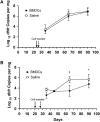CD40 Expression by B Cells Is Required for Optimal Immunity to Murine Pneumocystis Infection
- PMID: 38478734
- PMCID: PMC11481328
- DOI: 10.1093/infdis/jiae133
CD40 Expression by B Cells Is Required for Optimal Immunity to Murine Pneumocystis Infection
Abstract
CD40-CD40 ligand interactions are critical for controlling Pneumocystis infection. However, which CD40-expressing cell populations are important for this interaction have not been well defined. We used a cohousing mouse model of Pneumocystis infection, combined with flow cytometry and quantitative polymerase chain reaction, to examine the ability of different populations of cells from C57BL/6 mice to reconstitute immunity in CD40 knockout mice. Unfractionated splenocytes, as well as purified B cells, were able to control Pneumocystis infection, while B cell-depleted splenocytes and unstimulated bone marrow-derived dendritic cells were unable to control infection in CD40 knockout mice. Pneumocystis antigen-pulsed bone marrow-derived dendritic cells showed early but limited control of infection. Additional findings were consistent with recent studies that suggested a role for antigen presentation by B cells; specifically, by using cells from immunized animals, B cells were able to present Pneumocystis antigens to induce proliferation of T cells. Thus, CD40 expression by B cells appears necessary for robust immunity to Pneumocystis.
Keywords: Pneumocystis pneumonia; B cells; CD40; CD40L; mouse model.
Published by Oxford University Press on behalf of Infectious Diseases Society of America 2024.
Conflict of interest statement
Potential conflicts of interest. All authors: No reported conflicts. All authors have submitted the ICMJE Form for Disclosure of Potential Conflicts of Interest.
Figures





Update of
-
CD40 Expression by B cells is Required for Optimal Immunity to Murine Pneumocystis Infection.bioRxiv [Preprint]. 2024 Feb 5:2024.02.05.578900. doi: 10.1101/2024.02.05.578900. bioRxiv. 2024. Update in: J Infect Dis. 2024 Oct 16;230(4):1033-1041. doi: 10.1093/infdis/jiae133. PMID: 38410485 Free PMC article. Updated. Preprint.
Similar articles
-
CD40 Expression by B cells is Required for Optimal Immunity to Murine Pneumocystis Infection.bioRxiv [Preprint]. 2024 Feb 5:2024.02.05.578900. doi: 10.1101/2024.02.05.578900. bioRxiv. 2024. Update in: J Infect Dis. 2024 Oct 16;230(4):1033-1041. doi: 10.1093/infdis/jiae133. PMID: 38410485 Free PMC article. Updated. Preprint.
-
CD40 ligand is required for resolution of Pneumocystis carinii pneumonia in mice.J Immunol. 1995 Oct 1;155(7):3525-9. J Immunol. 1995. PMID: 7561048
-
CD40-CD40 ligand interactions are critical in T-B cooperation but not for other anti-viral CD4+ T cell functions.J Exp Med. 1996 May 1;183(5):2209-18. doi: 10.1084/jem.183.5.2209. J Exp Med. 1996. PMID: 8642330 Free PMC article.
-
Functions of CD40 and Its Ligand, gp39 (CD40L).Crit Rev Immunol. 2017;37(2-6):371-420. doi: 10.1615/CritRevImmunol.v37.i2-6.100. Crit Rev Immunol. 2017. PMID: 29773027 Review.
-
Functions of CD40 on B cells, dendritic cells and other cells.Curr Opin Immunol. 1997 Jun;9(3):330-7. doi: 10.1016/s0952-7915(97)80078-7. Curr Opin Immunol. 1997. PMID: 9203418 Review.
Cited by
-
Case Report: Severe Pneumocystis jirovecii pneumonia following zuberitamab treatment in autoimmune hemolytic anemia.Front Immunol. 2025 Mar 11;16:1546571. doi: 10.3389/fimmu.2025.1546571. eCollection 2025. Front Immunol. 2025. PMID: 40134426 Free PMC article.
-
The importance of Fcγ and C-type lectin receptors in host immune responses during Pneumocystis pneumonia.Infect Immun. 2025 Feb 18;93(2):e0027624. doi: 10.1128/iai.00276-24. Epub 2024 Dec 31. Infect Immun. 2025. PMID: 39745390 Free PMC article.
References
-
- Kovacs JA, Masur H. Evolving health effects of Pneumocystis: one hundred years of progress in diagnosis and treatment. JAMA 2009; 301:2578–85. - PubMed
-
- Thomas CF Jr, Limper AH. Pneumocystis pneumonia. N Engl J Med 2004; 350:2487–98. - PubMed
-
- Levy J, Espanol-Boren T, Thomas C, et al. . Clinical spectrum of X-linked hyper-IgM syndrome. J Pediatr 1997; 131:47–54. - PubMed
-
- Martin SI, Fishman JA. Pneumocystis pneumonia in solid organ transplantation. Am J Transplant 2013; 13:272–9. - PubMed
MeSH terms
Substances
Grants and funding
LinkOut - more resources
Full Text Sources
Research Materials

